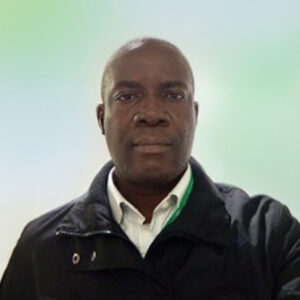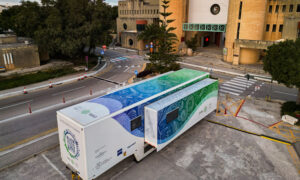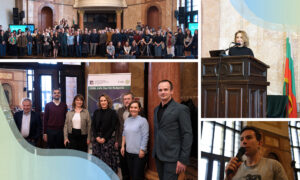
Sabbaticals at EMBL: a great opportunity for scientific exchange and growth
EMBL's Scientific Visitor Programme enables high-level scientific exchange and cross-fertilisation of ideas and technologies through sabbatical fellowships for researchers

Suitcase packed, passport ready, backpack on: does this sound familiar? In science, this is part of the job. Travelling for conferences, training, summer schools, fieldwork, joint projects, secondments, the next career step: one never runs short of good reasons.
Among them, sabbaticals offer scientists the chance to temporarily join another group or institution to gain fresh perspectives on their own research, learn new techniques, consider new ways to tackle challenging research questions, or cultivate collaborations. EMBL’s Scientific Visitor Programme facilitates such scientific stays hosted by a research group at any of its six sites, providing the necessary supportive infrastructure to successfully welcome scientists into the EMBL research community.
We spoke to three scientists who have recently spent their sabbaticals at EMBL. Here’s a bit of information about our visitors, followed by some of their reflections and experiences.

Adele Murrell (AM) is a professor at the University of Bath, UK. Her research group focuses on epigenetic mechanisms of gene regulation (i. e. how genes are activated and silenced when cells move from an uncommitted ‘stem cell’ state to a more specialised ‘differentiated’ state). Murrell and her team are exploring why cells already committed to one fate can’t change that destiny. Alterations in these mechanisms can result in an increased susceptibility to cancer, so Murrell’s group is growing breast and colon cancer cells in the lab to study their epigenetic differences from normal cells. Murrell spent a three-month sabbatical working with Talya Dayton and Kristina Haase at EMBL Barcelona.

Oladipo Omotosho (OO) is a senior lecturer at the University of Ibadan, Nigeria. His research focuses on bacterial and viral diseases and antimicrobial resistance in food animals. He is developing new genotyping tools for swine pathogens to improve disease prevention and control in Nigeria. He recently spent his sabbatical with the Lees Group at EMBL-EBI, UK.

Sidhartha Goyal (SG) is a physics professor at the University of Toronto, where he studies population dynamics on different levels. These include selection and competition among cells in a tissue or among species in an ecosystem, coevolution of bacteria with viruses, and competition among specialised cells upon genetic manipulation. Goyal spent three months at EMBL Heidelberg, working primarily in Hanh Vu’s lab and interacting closely with Anna Erzberger and her group. Here, he learned how to work with planarians – ancient worms commonly used in regeneration and cell population dynamics studies.
While Murrell and Omotosho had their stays funded through EMBL Sabbatical Visitor fellowships, Goyal’s visit was funded by a Theory@EMBL fellowship.
Why did you choose EMBL for your sabbatical?
AM: Culturing cells in the lab is a vital tool in our research, but there is one caveat: cells grown in the lab as mono-cultures (i.e. not surrounded by other cell types like in the body) change over time as a result of different factors. In recent years, several improvements have emerged, including growing cells as multicellular 3D structures called organoids. I am curious whether these systems are epigenetically closer to their original tissue. I chose to go to EMBL Barcelona precisely because of its focus on tissue engineering and tissue biology. I had read Kristina Haase’s paper about developing a microfluidic system to study placenta vasculature in 3D. I was also familiar with Talya Dayton’s work on organoid development.
OO: A lack of capacity in pathogen informatics is a limiting factor for understanding and offering solutions to the animal disease problem in Nigeria. I chose EMBL-EBI for my sabbatical to establish collaborations and to harness the vast amount of training resources, genome and protein data, and staff expertise there. The research focus and expertise in John Lees’s group fit my need for training and collaboration on pathogen informatics.
SG: The chance for a theorist like me to be immersed in a primarily experimental institute such as EMBL was extremely attractive. In addition, the generous support offered by the programme made it a feasible option even when travelling with a family. And above all, it was the willingness of Hanh and Anna to host me in their labs and welcome my family that finally convinced me to go.
How did your experience live up to your expectations?
AM: After several years in a teaching-intensive university, with a high administrative load, I hoped to be immersed within a research environment, observe the experimental set-up of organoids, and learn more about tissue engineering techniques. Not only were my expectations met, they were exceeded. The only pity was that three months went by far too quickly. I loved being in the lab, observing experiments, and attending many wonderful seminars by a variety of visiting and EMBL staff.
OO: I was looking to develop my skills and establish collaborations with bioinformatics experts. The EMBL-EBI programme was timely. The scope of training that I received in John Lees’s group went beyond initial expectations. Although the field of pathogen informatics is wide, I was guided on how to navigate and harness available research resources while continuing to improve my skills. The people at EMBL-EBI were welcoming, and the institute’s seminars and training series were useful.
SG: This experience absolutely exceeded my expectations! None of this would have been possible without the amazing support from Claudia Martin, EMBL’s Scientific Visitor Programme Manager. I was coming over with two young kids – a significant challenge – and Claudia made it happen. Everyone around me was extremely welcoming, both in and outside the lab. EMBL’s open-lab culture is unique, and I enjoyed the effortlessness in interactions that it led to.
How did this experience impact your career, both in the short and the long term?
AM: I hope we managed to lay the foundations for future collaborations and joint grant applications for some exciting cross-disciplinary research. One of my current roles at the University of Bath is as Director of Researcher Development. Being in the lab alongside EMBL students and postdocs showed me how their career expectations have changed since I started my own and gave me valuable insights that I will put into practice back home.
OO: The visit will remain a significant part of my career as a time for knowledge exchange. The skills gained have improved my research and teaching in many ways. I am now able to use more pathogen informatics software tools to handle large genomic datasets. I also built a relationship with the Lees Group and other EMBL-EBI researchers for future collaborations. In the long term, I will integrate new bioinformatic techniques into my research and in how I teach a module on diagnostic medicine at my home university. Last but not least, I hope to strengthen the capacity for genomic investigation within my home institution.
SG: My time in Hanh’s and Anna’s labs was very exciting, and we certainly have ideas that I am excited to work closely on with them in the near future. If the stars align, we may even bring some planarians to my lab in Toronto!
What ideas and lessons did you bring back from your work at EMBL?
AM: I gained knowledge and understanding of the processes behind organoid and tissue engineering. I appreciated being able to speak to so many people at EMBL to see what work is being done. With these insights, I hope to consolidate my research ideas, and tissue engineering systems will be a large part of that. The University of Bath also has a vibrant Centre for Bioengineering and Biomedical Technologies, and we would be honoured to host EMBL Barcelona scientists to see what further synergies and collaborations we can set up. I was very impressed by the motivation and enthusiasm of the students and postdocs at EMBL Barcelona. I already have plans to introduce journal clubs back home, featuring papers from invited speakers.
OO: I gained bioinformatics skills that are aiding my research on animal pathogens, animal disease diagnosis, and training students at home. EMBL-EBI’s research culture with its different research talks, group meetings, and journal club sessions showed me the importance of academic discussions. I will model all these aspects in our laboratory.
SG: EMBL’s open-lab culture and its many exciting programmes and talks allowed me to interact with many amazing scientists. I was especially impressed with EMBL’s predocs. I also learned basic planaria husbandry and designed some possible experiments related to physiological and neural memory. Additionally, I started digging into different aspects of planaria budding.
What was most memorable about your EMBL sabbatical?
AM: In Talya’s lab, I was fascinated by the biology of neuroendocrine tumours – tumours arising from cells of the hormonal and nervous system. I hadn’t appreciated their complexity or how difficult it is to grow them as organoids since we don’t know much about their normal microenvironment. Consequently, I was excited to see that culturing them in a defined broth with a growth-enhancing ingredient mix could potentially inform us more about their normal microenvironment.
OO: My experience during the weeklong intensive training on ‘Working with Bacterial Genomes’ was especially fulfilling. I found I was able to follow the course modules and smoothly navigate through the software using the given commands.
SG: Working with Hanh and Eva Pillai, a joint postdoctoral fellow between Arendt Group and Diz-Muñoz Group, I really appreciated being able to design experiments for the predoc course. We came up with a completely new learning experiment for planaria. We were a bit nervous, but the students accepted the challenge and it even generated interesting data that showed how one planaria species learned faster than another. Witnessing a new, raw idea come to life was thrilling, and the interactions with Hanh, Eva, and courageous predocs made it memorable.
If you are interested in pursuing a sabbatical at EMBL you can find more information here about all the fellowships options for different career levels.



